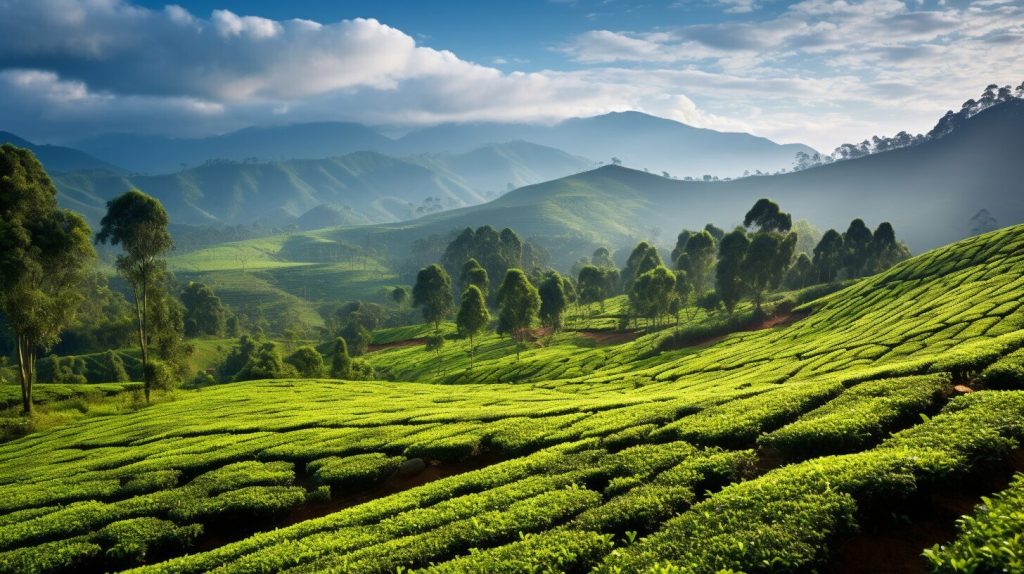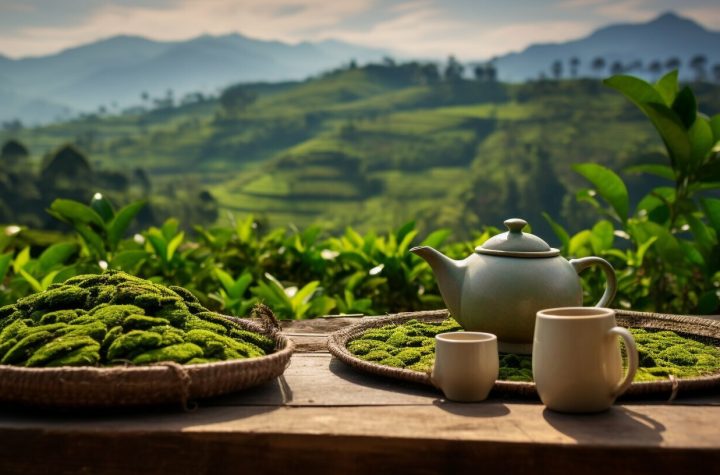
When it comes to black tea, Sri Lanka is one of the top producers in the world. The history of tea production in the country dates back to the early 19th century when the British introduced large-scale tea plantations. Today, the tea industry in Sri Lanka is thriving, producing some of the most sought-after teas in the world.
One of the most famous varieties of black tea from Sri Lanka is Ceylon tea, named after the country’s former name. This tea is known for its rich aroma and strong flavor, and is enjoyed by tea lovers around the globe. The process of producing Ceylon tea involves withering the tea leaves, rolling them and fermenting them before they are dried and sorted.
The tea industry plays a significant role in the Sri Lankan economy, providing employment opportunities to thousands of people. It is also a major contributor to the country’s export earnings. Overall, black tea is an important part of Sri Lanka’s culture and heritage.
Key Takeaways:
- Sri Lanka is known for its high-quality black tea production.
- Ceylon tea is a popular variety of black tea from Sri Lanka.
- The process of producing Ceylon tea involves withering, rolling, fermenting, and drying the tea leaves.
- The tea industry in Sri Lanka provides employment opportunities and is a major contributor to the country’s export earnings.
The History and Cultural Significance of Black Tea in Sri Lanka
Black tea has a long and fascinating history in Sri Lanka, which stretches back centuries. The tea industry in the country has been a vital part of its economy and culture, shaping the landscape and the people who inhabit it.
Tea plantations were first established in Sri Lanka during the colonial period when the British began cultivating tea on the island. Before this, the island was known primarily for its coffee production, but a coffee blight in the 1860s devastated the industry, and tea became the next viable option.
James Taylor, a Scotsman, is credited with being the first person to successfully cultivate tea on a Sri Lankan plantation in 1867. His success laid the foundations for the thriving tea industry the country is known for today.
The Evolution of Tea Processing Techniques
Tea processing techniques have evolved significantly since the first plantations were established. In the beginning, black tea was made through a process known as “orthodox” processing, which involved several stages of withering, rolling, oxidizing, and drying the leaves. This method is still used in many parts of Sri Lanka today.
However, in the early 20th century, a new technique called “CTC” processing was introduced, which stands for “crush, tear, and curl”. This method involves mechanically processing the tea leaves into small, uniform pieces, resulting in a stronger and more pungent brew. CTC processing is now widely used in Sri Lanka and is responsible for the country’s unique flavor profile.
The Significance of Tea Plantations in Sri Lanka
Tea plantations dominate the landscape of Sri Lanka’s central hills, covering vast swaths of land. These plantations not only provide a source of income for the country but also play an important role in its social and cultural fabric. Many of the workers on these plantations are descendants of the Tamil and Sinhalese laborers brought to the island during the colonial era, creating a diverse and multicultural society.
The Impact of Black Tea Production on Sri Lanka’s Economy
Black tea production is a significant contributor to Sri Lanka’s economy, generating billions of dollars in export revenue each year and providing jobs for thousands of people. The country is the world’s third-largest tea producer and the second-largest exporter after Kenya. The success of the tea industry has helped to elevate the standard of living for many Sri Lankans and has helped to position the country as a global leader in tea production.
The Flavors of Black Tea in Sri Lanka
Sri Lanka’s black teas are renowned for their rich aroma and diverse flavors. The country’s unique climate and soil conditions, combined with the expertise of its tea producers, result in a range of distinct and delicious teas.
One of the most popular black teas in Sri Lanka is Ceylon tea, known for its bold and robust flavor. This tea is made from leaves grown in the country’s high-elevation tea plantations and is renowned for its deep, reddish-brown hue and full-bodied taste.
Sri Lanka also produces a range of other black teas, each with its own distinctive flavor profile. For example, Dimbula tea has a delicate yet complex taste, with hints of citrus and floral notes. Uva tea, on the other hand, has a lighter, more floral taste, with a hint of spiciness.
The Flavor Profiles of Sri Lankan Black Teas
| Tea | Flavor Profile |
|---|---|
| Ceylon | Rich, full-bodied, bold, robust |
| Dimbula | Delicate, complex, floral, citrusy |
| Uva | Light, floral, slightly spiced |
Some of the other popular black teas produced in Sri Lanka include Nuwara Eliya tea, which has a delicate and floral taste, and Kandy tea, which is known for its spicy notes and rich aroma. Each tea has its own unique flavor, making Sri Lanka a top destination for tea lovers worldwide.
Pairing Sri Lankan Black Teas with Food
Sri Lankan black teas are incredibly versatile and can be paired with a wide range of foods. For example, Ceylon tea pairs well with savory dishes like curries and roasted meats, while Uva tea goes well with sweet treats like cakes and pastries. Dimbula tea is the perfect complement to delicate dishes like seafood and salads.
Overall, the diverse range of flavors and versatility of Sri Lankan black teas make them a must-try for any tea lover visiting the country.
The Role of Sri Lanka as a Leading Tea Exporter
Sri Lanka, also known as Ceylon, is a well-known producer and exporter of high-quality black tea. The country has a rich history of tea production that dates back to the 19th century when British colonizers established tea plantations in the region.
Today, Sri Lanka is the fourth-largest tea producer in the world, with an annual production of over 300 million kilograms of tea. More than half of this tea is exported worldwide, making Sri Lanka one of the largest tea exporters globally.
The Growth of Sri Lanka’s Tea Industry
Sri Lanka’s tea industry has grown exponentially over the years, thanks to the favorable climatic conditions and fertile soil in the country’s central highlands. The cool and misty climate, combined with the perfect blend of sunshine and rainfall, creates an ideal environment for cultivating high-quality tea.
Furthermore, Sri Lanka’s tea industry has benefited from a robust infrastructure that supports tea production and export. The country has an extensive network of tea plantations, factories, and processing facilities, enabling farmers to produce high-quality tea efficiently and cost-effectively.
Sri Lanka’s Competitive Edge as a Tea Exporter
Sri Lanka’s tea industry has gained a competitive edge in the global market due to several factors. Firstly, the country is known for producing premium-quality tea that is rich in flavor and aroma. This is thanks to the unique terroir of the country’s tea-growing regions, which gives Sri Lankan tea a distinct flavor profile that cannot be replicated elsewhere.
Secondly, Sri Lanka has a sophisticated tea-processing industry that uses advanced techniques to produce high-quality tea. The country has a strict grading system that ensures that all tea exports meet international quality standards.
Finally, Sri Lanka’s tea industry has a reputation for sustainability and ethical practices. Many tea plantations in the country follow sustainable farming practices that prioritize environmental conservation and worker welfare. This commitment to sustainability has helped Sri Lanka’s tea industry stand out in the global market.
Conclusion
Overall, Sri Lanka’s tea industry has played a significant role in the country’s economic development and global reputation. By producing and exporting high-quality black tea, Sri Lanka has cemented its position as a leading tea exporter and a key player in the global tea market.
The Art of Brewing and Enjoying Black Tea in Sri Lanka
In Sri Lanka, black tea is more than just a beverage – it’s a cultural ritual. From the bustling streets of Colombo to the tea estates in the central hills, Sri Lankans take great pride in their tea production and consumption. To truly experience the rich flavors and aromas of black tea in Sri Lanka, it’s important to understand the art of brewing and savoring loose leaf tea.
Selecting the Finest Loose Leaf Teas
Loose leaf tea is the preferred choice for brewing black tea in Sri Lanka. To select the finest loose leaf teas, look for teas that are manufactured using traditional methods. These teas are often referred to as “orthodox” teas and are more flavorful and aromatic than machine-processed teas. When selecting loose leaf teas, look for teas that have a rich, dark color and a strong aroma.
Mastering the Brewing Techniques
Once you’ve selected the perfect loose leaf tea, it’s time to brew the perfect cup. One of the most important factors in brewing black tea is the water temperature. In Sri Lanka, the water is typically heated to a temperature between 90-100°C (194-212°F) for brewing black tea. Allow the tea to steep for 2-3 minutes for a bold, robust flavor or up to 5 minutes for a more delicate flavor profile.
Enjoying the Flavors of Black Tea in Sri Lanka
Once your tea is brewed to perfection, it’s time to savor the flavors. In Sri Lanka, it’s common to add a splash of milk and a spoonful of sugar to the tea. This helps balance the bold flavor of the tea and adds a touch of sweetness. However, some tea connoisseurs prefer to enjoy their tea without any additives to fully experience the natural flavors of the tea.
Whether you prefer your tea bold and robust or delicate and floral, black tea in Sri Lanka offers a range of flavors to suit every palate. By selecting the finest loose leaf teas and mastering the brewing techniques, you can experience the true taste of Sri Lankan black tea and immerse yourself in the cultural rituals surrounding this beloved beverage.
FAQ
What is Ceylon tea?
Ceylon tea is a type of black tea that is grown and produced in Sri Lanka. It is renowned for its rich aroma and flavor.
How is black tea produced in Sri Lanka?
Black tea in Sri Lanka is produced through a process known as withering, rolling, oxidation, and drying. The tea leaves are withered, rolled to release enzymes, oxidized through exposure to air, and finally dried.
How big is the tea industry in Sri Lanka?
The tea industry plays a crucial role in Sri Lanka’s economy. It is one of the country’s main sources of foreign exchange and provides employment opportunities for a significant portion of the population.
What are the popular flavors of black tea in Sri Lanka?
Black tea in Sri Lanka is known for its diverse flavors. Some popular flavors include strong and bold teas, delicate and floral teas, and teas with hints of fruity or citrus notes.
Why is Sri Lanka a leading tea exporter?
Sri Lanka’s favorable climate and fertile soil make it ideal for tea cultivation. The country’s tea production is carefully regulated, ensuring high-quality standards. These factors, along with its long-standing tea traditions, have contributed to Sri Lanka’s position as a leading tea exporter.
How can I brew and enjoy black tea in Sri Lanka?
To brew black tea from Sri Lanka, start by selecting high-quality loose leaf tea. Use hot water, around 195°F (90°C), and steep the tea for 3-5 minutes. Enjoy the tea on its own or with milk and sweetener, according to your preference.





More Stories
Exploring the Beautiful Coconut Plantation in Sri Lanka
Discover What Gemstones are Found in Sri Lanka – A Jewel Feast!
Experience the Pure Flavor of Organic Tea – Naturally Good!